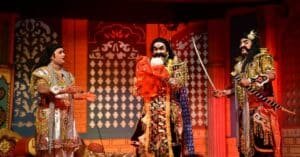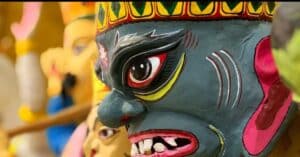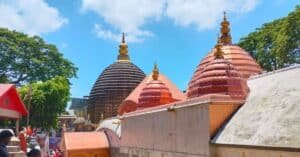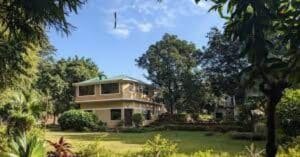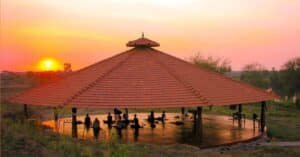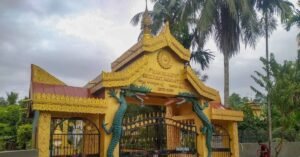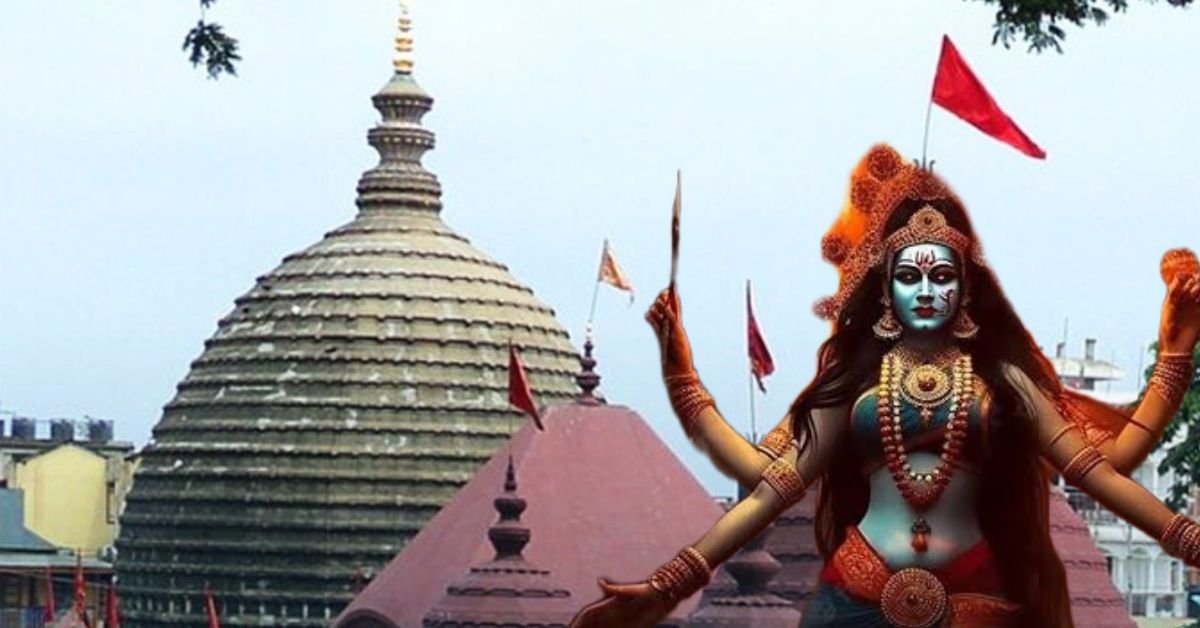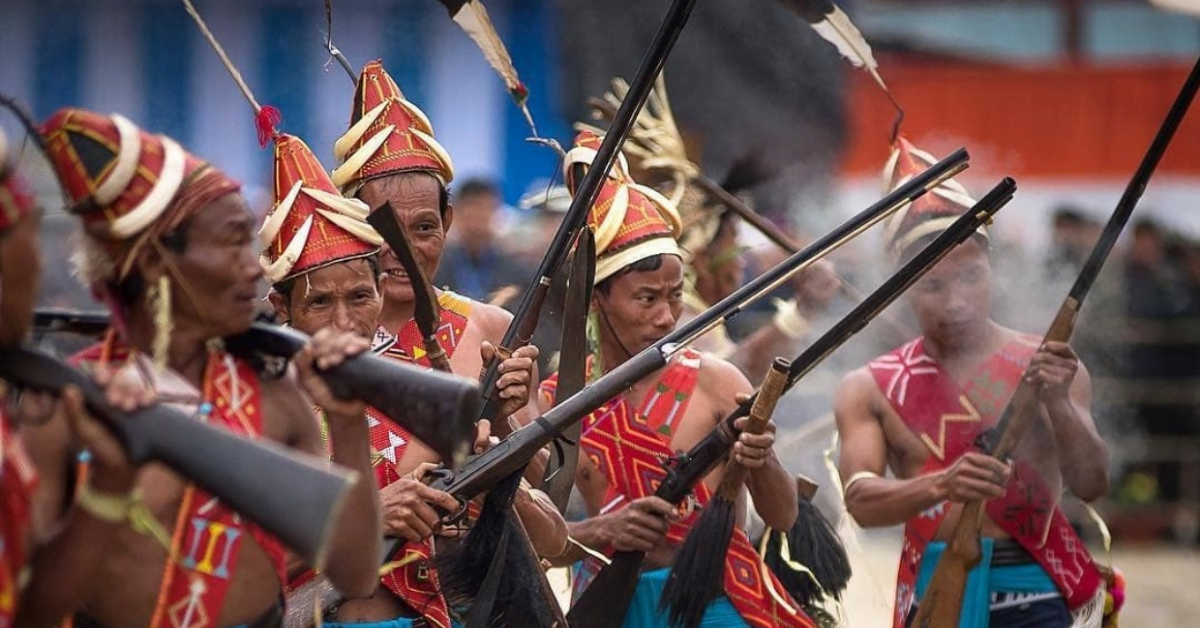Ankiya Naat Bhaona, commonly known as Bhaona, is a distinctive traditional performance art from Assam that deeply reflects the region’s cultural, spiritual, and social essence. To truly understand Assamese culture, one must delve into the study of Ankiya Bhaona. Here one can find the true essence of the medieval culture of Assam.
Bhaona is also an artistic tour de force of Assam, blending multiple art forms into a single cohesive experience. The performance is an amalgamation of music, dance, and visual art, with each element playing a crucial role in creating the overall impact.
Bhaona is popular name. In common parlance, we can literally translate it into theater. The plays of bhaona are popularly known as Ankiya Nats and their staging is known as Bhaona. So, it is sometimes combined as Ankiya Naat Bhaona.
“Ankiya” means “one-act” and “naat” means plays. By its literal sense, it means one-act play. However, Ankiya Naat involves performances by more than one people. That is why, it is sometimes seen as a misnomer by scholars. This aspect is discussed in the last part of this blog. Let us first discuss the basics of Ankiya Naat Bhaona.
Origin of Ankiya Naat Bhaona
It is rooted in the Bhakti movement led by Srimanta Sankaradeva in the 16th century. He created the form to convey religious messages to villagers through entertainment. In the medieval period, where common masses were illiterate, it was impossible for common people to grasp religious texts written in Sanskrit or Brajavali. Srimanta Sankaradeva decided to use this method for religious storytelling. His experiences with various folk theaters across India, such as Ramleela, Rashleela, and Kathakali, inspired him to create Bhaona.
The genesis of Bhaona is inextricably linked to Srimanta Sankaradeva’s reformist movement, the Ekasarana Naam Dharma, which sought to simplify and democratise Hindu religious practice. In a time marked by rigid caste hierarchies and ritualistic orthodoxy, Srimanta Sankaradeva used Bhaona propagate his message of universal devotion, egalitarianism, and the rejection of unnecessary rituals.
The first Ankiya Nat that came into existence was Chihna-Yatra where Shankardev himself played the role of Lord Vishnu. It is said that Sankardeva wrote seven dramas (ankiya naat) and performed them throughout various regions. Later, his disciples followed the tradition, wrote several drams and the generations after them improvised upon them.
The Storytelling
Bhaona performances are predominantly based on stories from Hindu mythology, particularly those found in texts like the Bhagavata Purana, the Ramayana, and the Mahabharata. Typically, the stories focus on the life and deeds of Krishna, a central figure in Vaishnavism, and explore his divine leelas with great emotional and spiritual depth. Through these mythological narratives, Bhaona highlioghted the eternal struggle between good and evil, the importance of living a righteous life, and the power of devotion to God.

The audience, often comprising rural villagers with limited access to formal education, can grasp these teachings through the simple, yet profound storytelling of Bhaona.
One of the distinctive features of Bhaona is its use of the Brajavali language, a linguistic blend of Assamese and Maithili, which was created by Sankaradeva himself. This hybrid language was a bridge between the sacred Sanskrit texts and the vernacular Assamese, allowing religious stories to be communicated in a way that retained their sanctity while being comprehensible to a wider audience.
Even today, these plays (Ankiya Naat) are performed in the Brajavali language. However, in recent times, Assamese has been incorporated alongside Brajavali to make them more accessible and appealing to younger audiences.
The Stage
Bhaonas are performed primarily in Naamghars, which are socio-religious institutions that double up as cultural centres in Assamese villages. The Naamghar, conceived by Sankaradeva, is not just a place of worship; it is the beating heart of village life. The staging of Bhaona in naamghars underscores its role as a community theatre, where people from all walks of life gather to share in a collective spiritual and cultural experience.

Main Components of Bhaona
As we said earlier, Bhoana is an amalgamation of music, dance, and visual art, with each element playing a crucial role in creating the overall impact. Music, in particular, is central to Bhaona.
Borgeet
Borgeets are a collection of lyrical songs, composed by Srimanta Sankardeva and Madhavdeva in the 15th-16th centuries, are used to begin prayer services in Assamese monasteries, e.g. Satra and Namghar. Borgeets were composed before Bhaonas came into being.
These Borgeets form the musical foundation of the performances. Borgeet is typically accompanied by traditional Assamese instruments such as the khol (a percussion instrument), taal (cymbals), and the nagara (a drum).

Sattriya Dance
Dance also plays a significant role in Bhaona, with the actors often incorporating elements of Sattriya, a classical dance form that originated within the satras of Assam. Sattriya, which is characterised by its graceful movements and intricate footwork, adds a dynamic visual component to the storytelling in Bhaona, enhancing both its aesthetic appeal and its spiritual depth. All characters enter and depart through lyrical steps in specific raga and taala.

Mukha
Mukha in Assamese means Mask. One of the most visually striking aspects of Bhaona is the use of mukhas or masks, to represent various mythological characters, including gods, demons, and animals. These masks are meticulously crafted by skilled artisans. The mukhas not only add a sense of spectacle and drama to the performance but also serve as a form of visual storytelling, helping the audience differentiate between the characters and their roles in the narrative. It is to be noted that masks are not used in all types of Bhaona.
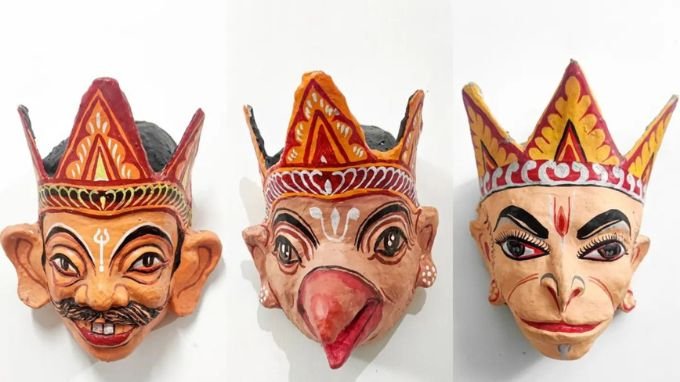
The craftsmanship involved in creating these masks is a testament to Assam’s rich tradition of folk art. Read this blog for more about Mask Making or Mukha Silpa of Assam.
Main Characters
While many characters are introduced during a Bhaona, depending on the story, there are certain key characters that appear in every performance and form the essence of Bhaona.
♦ Sutradhar or Sutradhari: The Sutradhar is an essential figure in Bhaona, responsible for reciting slokas (hymns), singing, dancing, and explaining each stage of the performance in prose. No Bhaona can take place without the Sutradhar, as he ensures the audience remains engaged with the story. Sutradhar would introduce the plot and characters, and recite a verse to initiate the performance. The orchestra and performers would then enter the stage. A sutradhar can be both a male and a female.
♦ Bhaoriya : Bhaoriyas are the performers in Bhaona, with the term literally meaning “one who is pretending.” Traditionally, Bhaoriyas were exclusively male, with men dressing as women when required by the story. However, in recent times, many women have also taken up the role of Bhaoriya, performing alongside men.
♦ Gayan : The singers.
♦ Bayan : The musicians. They play khol (a percussion instrument), taal (cymbals), the nagara (a drum) and other musical instruments.

Costumes used in Bhaona
The costume of Bhaona is unique and prepared from locally available materials. The pag, or headgear, worn by Gayan and Bayan (the musicians) and Sutradhar vary from place to place.
Among many designs, koshapatiya pag (pag means headgear) is more common or popular for Sutradhara. On the other hand, Gayan-Bayan’s pag is a little small. It’s called khekerupatiya or gosai pag, which exposes the forehead. Bhaona incorporated costumes from various traditional dances of Assam; e.g. the ghuri or lehenga of Sutradhara were inspired from Ojapali (a traditional dance form of Assam) .
The actors used paints for their makeup, befitting their roles. Earlier though performers used hengul (cinnabar) and haital (yellow orpiment), now a day the professional performers use artificial and easily available makeup.
Types of Bhaona
When Srimanta Sankardeva introduced Bhaona in the 16th century, it did not have distinct variations. Over time, Bhaona has evolved, and today, there are many different types of bhaona performed in Assam. Bhaona evolved into many forms based on the overall theme or structure of Ankiya Bhaona.
- Phaujiya Bhaona (started in Koch Behar),
- Mukha Bhaona (Bhaona performed wearing a mask mainly in Majuli),
- Matribhasha Bhaona (Bhaona of the Assamese mother tongue popular in upper Assam)
- Baresohoria Bhaona and Hazari Bhaona (simultaneous performance of many Bhaonas under a single pandal, performed mainly in Nagaon district of Assam)
- Dhura Bhaona (it originated from the Dhup kirtan of Bengal, flourished in Barpeta Satra and Kamalabari Satra)
Similarly, Dhuliya/Khuliya Bhaona, Sabah Bhaona, Juri, and Cukraganar Bhaona (Sutradhara characters not available), Buka Bhaona, Pani Bhaona, and many other little-known terms of Bhaona are available in every nook and corner of Assam.
Bhaona In Contemporary Times
In contemporary times, Bhaona continues to serve as a vital link between the past and the present, helping to preserve Assamese culture in the face of rapid modernisation and globalisation. Bhaona remains a living tradition that continues to draw audiences across Assam. The survival of Bhaona in the modern world is a testament to its adaptability and resilience.

While it remains deeply rooted in tradition, Bhaona has also evolved to incorporate contemporary themes and issues, ensuring its continued relevance. Some modern Bhaona performances have begun to address pressing social concerns, such as environmental degradation, corruption, and gender inequality, while still maintaining the mythological framework that is central to the art form.
Where To Watch Traditional Bhaona
Bhaonas are performed in traditional Namghars and Satras across Assam, with numerous performances available on YouTube and Facebook. However, to experience an authentic live Bhaona, Majuli Island of Assam is the ideal destination. Majuli has preserved this tradition in its original form, and visiting during the Raas Mahotsav (led in October-November) offers a unique opportunity to witness Ankiya Naat Bhaona. Additionally, Barpeta Satra is another great location to see Bhaona performances, which are held on special religious occasions in Assam.
Why Ankiya Naat Bhaona is a misnomer?
Originally, only Ankiya Nats—dramas written in Brajavali by Srimanta Sankardeva and Madhavdev—were referred to as Bhaona, specifically Ankiya Bhaona. According to historians, these plays were performed by a single person, the Sutradhar, making them true one-act plays or Ankiya Naat Bhaona in the literal sense.
After Sankardeva’s death, his disciples, including Madhavdev, Gopal Ata, and Daityari Thakur, did not strictly adhere to the original format of Bhaona. They introduced new linguistic styles and storylines to make it more relatable to the common people.
As time passed, Ankiya Naat evolved into a cultural phenomenon, incorporating dance, music, and drama into a single performance. Today’s Bhaona requires a large troupe of artists, making the term “Ankiya Naat Bhaona” seem like a misnomer to some scholars, who now simply refer to it as Bhaona.
FAQs related to Ankiya Naat Bhaona
Q: What are seven Ankiya Naats (plays) written by Srimanta Sankardev?
A: Chihna-yatra”, “Patni Prasad”, “Parijat Haran”, “Kaliya Daman”, “Keli Gopal”, “Rukmini Haran” and “Rama Vijay”.


